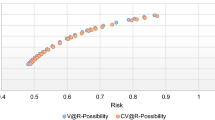Abstract
We study a static portfolio selection problem, in which future returns of securities are given as fuzzy sets. In contrast to traditional analysis, we assume that investment decisions are not based on statistical expectation values, but rather on maximal and minimal potential returns resulting from the so-called α-cuts of these fuzzy sets. By aggregating over all α-cuts and assigning weights for both best and worst possible cases we get a new objective function to derive an optimal portfolio. Allowing for short sales and modelling α-cuts in ellipsoidal shape, we obtain the optimal portfolio as the unique solution of a simple optimization problem. Since our model does not include any stochastic assumptions, we present a procedure, which turns the data of observable returns as well as experts’ expectations into fuzzy sets in order to quantify the potential future returns and the investment risk.
Similar content being viewed by others
References
Arnold B., Hauenschild N., Stahlecker P. (2004) Monopolistic price setting under fuzzy information. European Journal of Operational Research 154: 787–803
Arnold B., Stahlecker P. (2010) Uniformly best estimation in linear regression when prior information is fuzzy. Statistical Papers/Statistische Hefte 51: 485–496
Bandemer H., Gottwald S. (1993) Einführung in Fuzzy-Methoden. Akademie Verlag, Berlin
Carlsson C., Fullér R. (2001) On possibilistic mean value and variance of fuzzy numbers. Fuzzy Sets and Systems 122: 315–326
Duan, L. (2010). Portfolio-Modelle mit unscharfen Parametern—Ein theoretischer und empirischer Ver- gleich mit dem klassischen Modell nach Markowitz., PhD thesis, Universität Hamburg, Hamburg. (In German).
Fang Y., Lai K. K., Wang S. (2008) Fuzzy portfolio optimization: theory and methods. Springer, Berlin
Hauenschild N., Stahlecker P. (2003) Nash-equilibria in a heterogeneous oligopoly with fuzzy information. Review of Economic Design 8: 165–184
Huang X. (2009) A review of credibilistic portfolio selection. Fuzzy Optimization and Decisision Making 8: 263–281
Huang X. (2010) Portfolio analysis: from probabilistic to credibilistic and uncertain approaches. Springer, Berlin, Heidelberg
Inuiguchi M., Ramík J. (2000) Possibilistic linear programming: a brief review of fuzzy mathematical programming and a comparison with stochastic programming in portfolio selection problem. Fuzzy Sets and Systems 111: 3–28
Khachiyan L. G., Todd M. J. (1993) On the complexity of approximating the maximal inscribed ellipsoid for a polytope. Mathematical Programming 61: 137–159
Lai K., Wang S., Xu J., Zhu S., Fang Y. (2002) A class of linear interval programming problems and its application to portfolio selection. IEEE Transactions on Fuzzy Systems 10(6): 698–703
Li J., Xu J. (2007) A class of possibilistic portfolio selection models with interval coefficients and its application. Fuzzy Optimization and Decision Making 6: 123–137
Markowitz, H. M. (1989). Mean-variance analysis in portfolio choice and capital markets, reprint edn. Oxford: Blackwell
Markowitz H. M. (2008) Portfolio selection: die Grundlagen der optimalen Portfolio-Auswahl (1st ed.). FinanzBuch-Verlag, München
Moshtagh, N. (2010). ‘Minimum volume enclosing ellipsoid algorithmus’, http://www.mathworks.com/matlabcentral/fileexchange/9542
Poddig T., Dichtl H., Petersmeier K. (2003) Statistik, Ökonometrie, Optimierung: Methoden und ihre praktische Anwendung in Finanzanalyse und Portfoliomanagement. Uhlenbruch Verlag, Bad Soden/Ts
Stahlecker P., Hauenschild N., Klintworth M. (2003) Optimierung unduökonomische Analyse. Springer, Berlin
Stahlecker P., Schmidt K. (1989) Approximation linearer Ungleichungsrestriktionen im linearen Regressionsmodell. Allgemeines Statistisches Archiv 73: 184–194
Tanaka H., Guo P., Türksen I. (2000) Portfolio selection based on fuzzy probabilities and possibility distributions. Fuzzy Sets and Systems 111: 387–397
Todd M. J., Yidirum E. A. (2007) On khachiyan’s algorithm for the computation of minimum volume enclosing ellispoids. Discrete Applied Mathematics 155: 1731–1744
Van Leekwijck W., Kerre E. E. (1999) Defuzzifcation: criteria and classifcation. Fuzzy Sets and Systems 108: 159–178
Wang S., Zhu S. (2002) On fuzzy portfolio selection problems. Fuzzy Optimization and Decision Making 1: 361–377
Author information
Authors and Affiliations
Corresponding author
Rights and permissions
About this article
Cite this article
Duan, L., Stahlecker, P. A portfolio selection model using fuzzy returns. Fuzzy Optim Decis Making 10, 167–191 (2011). https://doi.org/10.1007/s10700-011-9101-x
Published:
Issue Date:
DOI: https://doi.org/10.1007/s10700-011-9101-x




